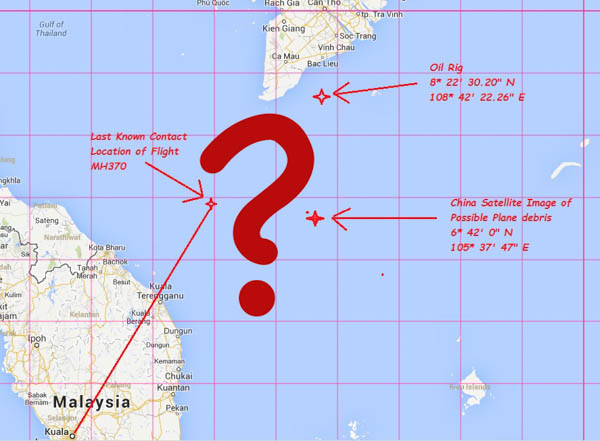Photo by: Abby Bellow
After four weeks of searching, Malaysian Airlines Flight 370’s whereabouts remain unknown.
The flight from Kuala Lumpur, Malaysia to Beijing, China with 239 people aboard vanished without a trace on March 8.
“Airplanes don’t just disappear into thin air, but this one apparently did,” senior Chas Carter said. “It’s a strange situation.”
A seemingly routine flight, the Boeing 777-200ER took off from Kuala Lumpur at 12:41 a.m. Saturday (11:41 p.m. Friday CT), and was scheduled to arrive in Beijing at 6:30 a.m. after a roughly 2,700-mile trip. At 1:30 a.m. air traffic controllers outside Kuala Lumpur lost contact with the aircraft.
Charles Rix, associate professor of Bible and a self-proclaimed “student” of airline disasters, said this missing flight is a tragic oddity.
“Of all the major air mysteries involving commercial airliners … of all the major ones and even some of the minor ones, there was always some evidence of a catastrophic event aboard the airplane, or there was some indication that there was a problem,” Rix said.
In every case that Rix knows of, there always was an eyewitness or easily discoverable debris. The missing Malaysian flight has neither.
The most recent case of a missing airliner was Air France Flight 447, which crashed into the Atlantic Ocean on June 1, 2009. The aircraft was missing for five days until debris and bodies were found. The black box, a flight data recorder, was found nearly two years later.
“The Air France facilities in Paris knew that there was a problem even though they couldn’t find debris,” Rix said. “Even the absence of being able to find debris or people – there was always a pretty clear knowledge that something went wrong and why.”
Aircraft, ships and satellites have scoured the Indian Ocean and surrounding areas in search of any evidence of the plane’s whereabouts. Recent claims of spotted debris from the airplane have all come back as false. Nothing concrete has yet been found. Teams continue to search for evidence in the South Indian Ocean where the aircraft is suspected to have diverted.
According to the Associated Press, several countries have dedicated aircraft and ships to aid in the search. Australia sent one P-3 Orion plane and three navy ships; Malaysia distributed two C-130 Hercules planes; China sent one Il-76 plane and eight ships; Japan sent one P-3 Orion and a coast guard jet; New Zealand sent one military P-3 Orion and one civilian plane; South Korea dedicated one P-3 Orion and the United States distributed one P-8 Poseidon plane.
“In this situation, the thing that is so unprecedented is that there doesn’t seem to be any conclusive evidence on even what happened,” Rix said. “What’s coming out of the Malaysian government changes almost every day.”
Malaysia released a full transcript from the flight on Tuesday. Communications from the pilots and air traffic controllers from preflight checks to the last recorded message were included in the transcript. Malaysian officials indicated that there was nothing abnormal in the transcript.
“Good night, Malaysian Three Seven Zero” was the last recorded message from the flight at 01:19 a.m. The last transmission from the plane’s communication transponder was at 1:21 a.m., and it disappeared from Malaysian air traffic control radar at 1:30 a.m.
Malaysian officials’ credibility has been questioned since the beginning, but after changing accounts and the falsely reported last transmission from the aircraft as “All right, good night,” their reports are viewed as less reliable.
“There has been very little to tell and a lot of unanswered questions,” Andrew Herdman, the director-general of the Association of Asia Pacific Airlines, said to the Associated Press. “There is frustration on the lack of new information, frustration over progress with investigations and the search. That frustration is being channeled to the Malaysian authorities, but I think it’s a bit premature to use that to reflect adversely on how they are doing.”
The lack of available information raises questions as to what the Malaysian government really knows and if they’re holding information back.
“You definitely get the feeling that there is more known by certain governments than they are willing to share,” Rix said. “Nothing adds up. Nothing makes sense. How can a plane keep flying for that long and not be picked up by military radar? Where is that information?”
No sign of the 239 people aboard has been found or released. Families of the missing have zero indication whether their loved ones are alive or dead.
On the flight was Oklahoma Christian alumnus Philip Wood.
“The Oklahoma Christian University community was shocked and saddened to learn yesterday that Philip was on this flight,” Executive Vice President Bill Goad said the day after the flight went missing. “The thoughts and prayers of his many friends in the OC community are with the family at this time.”
According to the university, Wood graduated Oklahoma Christian with a degree in computer science in 1985. He recently moved from North Texas to Beijing, where he worked as an executive with IBM.
As crews continue to search, Rix said it’s important to realize the tragedy behind the headlines.
“Remember the families,” Rix said. “This is loss without closure. It’s extremely difficult to get over that when you don’t know what happened. There are a lot of people who may never know what happened – that’s just really hard to deal with.”













Be First to Comment